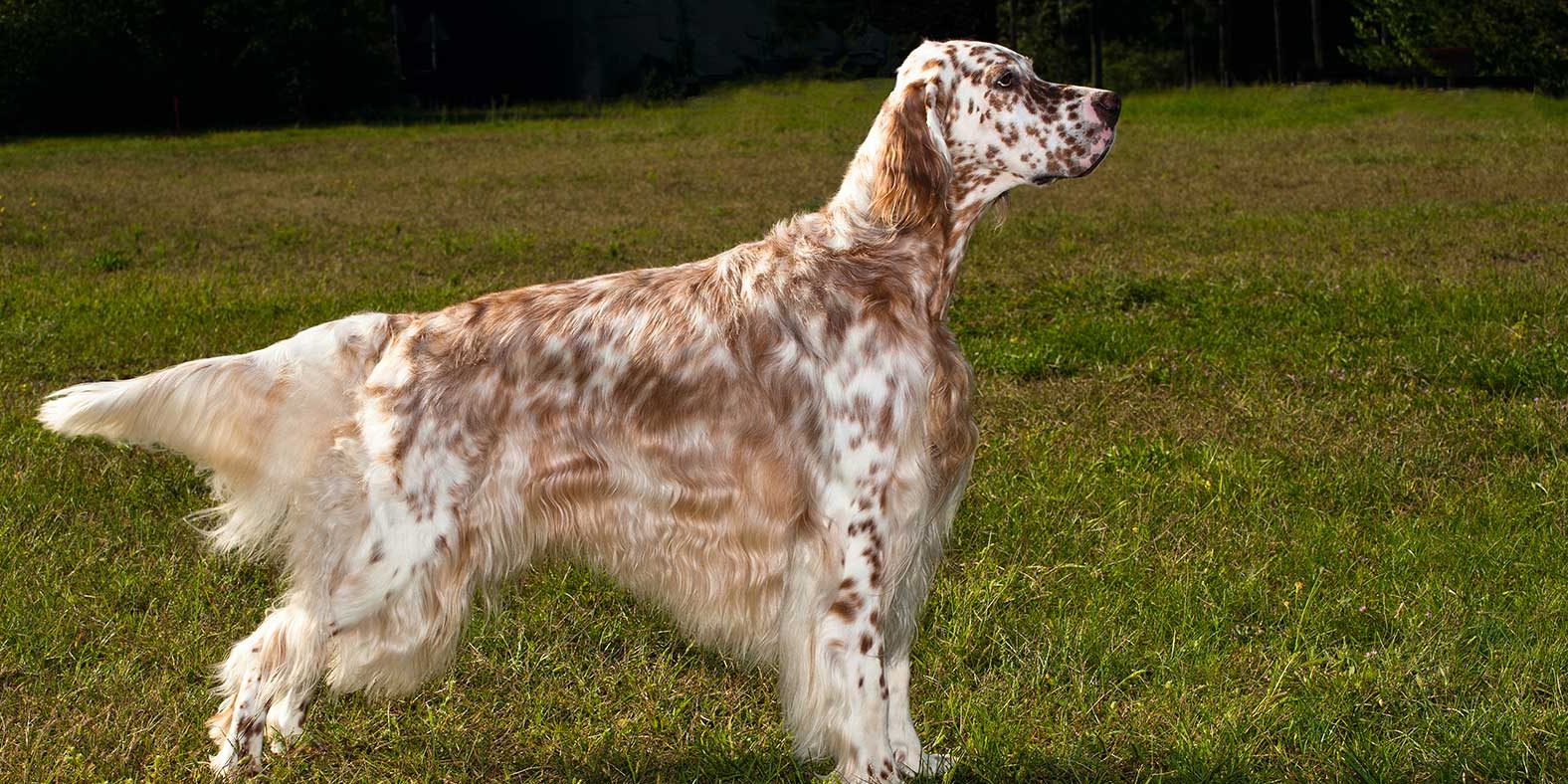-
Activity Level:
high
-
Shedding Level:
moderate
-
Grooming Level:
moderate
-
Trainability:
high
-
Good for Novice Owners:
moderate
-
Adaptability:
moderate
-
Kid/Pet Friendly:
often
-
Prey Drive:
high
-
Watchdog:
very alert
- Average Size: Medium
- Average Lifespan: 11-15 years
- Registered?: aca, akc
English Setter Dog Breed Information
Overview
Temperament
Adaptability
Health
Owner Experience
Grooming
Activity Level
Size
Life Span
Did You Know?
The English Setter originated in England over 400 years ago as a trained bird dog. This dog breed was bred to hunt and track upland birds, like quail, pheasant, and grouse, over long distances. The appearance of the modern English Setter is thanks to two Englishmen, Edward Laverack and Purcell Llewllin, who developed strains of the breed during the 1800s.
The first English Setter came to the United States in 1874. One of the facts about English Setters is that it was one of the first dog breeds recognized by the AKC upon establishment in 1878 and is part of the Sporting Group.
The English Setter is a responsive, energetic, intelligent, and friendly dog breed. They have a sweet nature, gentle disposition, and can have a mischievous side. Their loving and affectionate nature tends to make them excellent companions and family pets. They also get along well with children and other dogs. They’re also known as one of the kid-friendly dog breeds.
They were bred to hunt and track small animals, so they do tend to have a high prey drive and urge to chase. They can get along well with other pets if they have grown up together or have been introduced to them properly. They tend to be excellent watchdogs as their instincts keep them alert, but they do not tend to make good guard dogs as they are more interested in meeting and making friends.
English Setters are moderately adaptable dogs. They are best suited to homes with securely fenced-in yards where they can run off-leash. They do not tend to be a good fit for apartment living.
They can adapt to apartment living as long as they get enough exercise, but this requires the owner to live a very active lifestyle where they are able to consistently give their dog exercise, attention, and mental stimulation.
This dog breed does well in almost any climate. As with many dog breeds, they are sensitive to extreme heat or cold. Because they have a lighter structure, you may want to invest in a sweater or coat and other winter dog products to help keep them warm when they are outside with you in colder temperatures.
These dogs are also sensitive souls that thrive on human attention and company, which means they do not like to be left alone for long periods of time. They also get bored easily and can exhibit destructive behavior if they do not get enough exercise or mental stimulation.
Potential health concerns to be aware of in English Setters can include hip dysplasia, congenital deafness, thyroid problems, elbow dysplasia, and allergies. Good breeding practices and the health of the parents make a big difference in the health of English Setter puppies.
Reputable breeders will screen their dogs before breeding to make sure they are not passing preventable issues to puppies. Make sure you ask about the health and genetic history of both parents. You can also ask about any health tests or clearances that have been done. The English Setter Association of America, Inc. recommends BAER testing, an elbow evaluation, a hip evaluation, and a thyroid evaluation.
As a barrel-chested dog, the English Setter is also at a higher risk of bloat. Bloat in dogs can be dangerous and quickly becomes fatal if gastric torsion occurs (i.e.; if the stomach flips). It’s important to know how to reduce the risk and what symptoms mean that it’s time to get to the emergency vet.
The English Setter is a highly intelligent dog breed. They are sensitive and in tune with their owners, so they often pick up on things very quickly. Because they are sensitive, they respond best to rewards and praise-based training. Harsh tones or corrections are unnecessary and can damage the bond you’re building with your dog.
Although these dogs are highly trainable, they are also high-energy dogs, which means they can get bored easily, sometimes have a stubborn streak, and usually require an owner with some experience owning and training high-energy working dogs. A novice or first-time dog owner can be a good fit for English Setters, but puppy training classes are recommended to ensure both owner and pup establish a consistent and positive bond during training.
English Setters usually have a straight, medium-length coat with a slight wave or feathering towards the end. Their coat is white with overlay markings that often resemble freckles or speckles. They are called Belton and can create larger swathes of color along the main trunk of the body. Some common coat colors for these markings include orange, liver, lemon, blue, and tricolor.
The English Setter will shed moderately throughout the year with two heavier shedding sessions as the seasons change. Brushing their coat a few times a week is usually sufficient to remove tangles and prevent mats from forming. You may want to increase to daily brushing when they are going through their seasonal shedding sessions as they will shed more during those times.
A soft bristle brush and a comb for gently working through tangles are good dog grooming brushes for a Setter coat. Not only will regular, and frequent, brushing help keep your dog more comfortable, but it will also keep loose fur contained to your brush instead of ending up all over the house. Your English Setter also needs the occasional bath every 4-6 weeks to keep their coat clean. They may need to be bathed more frequently if they’ve gotten dirty on their outdoor adventures with you.
In addition to basic coat care, you will also need to care for your English Setter’s nails, ears, and teeth. As active dogs, the English Setter may wear down their nails naturally. But, you will still want to check their paws and trim or file their nails once or twice monthly as needed. This ensures their nails do not get too long and start to make movement painful and difficult.
Ears, especially floppy ears, tend to trap dirt, moisture, and debris, which can lead to ear infections. Checking your dog’s ears regularly and carefully cleaning them as needed helps keep your dog’s ears healthy and helps to prevent ear infections. Plus, if you see anything concerning, you can catch it early and get to the vet before your dog starts feeling unwell.
Dental care is so important for dogs, but it is often overlooked, which is why dental disease is one of the most common health issues in dogs. It’s also the most preventable. Just like tartar and plaque buildup causes gum disease and tooth decay in humans; it does the same in dogs.
Proper dental care for dogs is all about preventing tartar from building up in the first place, which protects your dog’s gums and teeth. Brushing your dog’s teeth or using an enzyme toothpaste every day is the best thing you can do to prevent dental disease in your dog. In addition to cleanings at the vet when needed, you can also supplement your efforts with dental hygiene chews and a special dental care diet.
All of these grooming tasks are just part of taking care of your pup and making sure they stay happy and healthy. Getting your English Setter used to having their mouth, paws, and ears handled as a puppy and rewarding them during grooming sessions can help make regular grooming a much easier process for the both of you. They can even help you build a bond with your dog and become positive bonding sessions that your dog looks forward to!
This is a high-energy dog breed that requires plenty of exercise. In addition to daily walks, they will require playtime and more rigorous activity throughout the day. In many cases, an English Setter will be up for more activity if you are. Although they may act like a couch potato when they are inside, provided they have gotten plenty of exercise already, the English Setter is definitely not a couch potato dog and requires an active lifestyle to stay happy and healthy.
This dog will be happy to be doing almost anything as long as it means they will be able to be near you while being active. Their endurance makes them one of the dog breeds that make good running partners for short or moderate distances. Just make sure puppies are finished growing before you jump into high-impact activities to avoid damaging developing bones and joints.
English Setters are also one of the dog breeds that tend to love water, so will likely be happy to go for a swim. Hiking, trips to the dog park, games of fetch, and more are all great activities to do with your English Setter. As a working dog, the English Setter also needs a job to do. This, paired with their high energy, makes them a good fit for dog sports like agility, dock diving, flyball, field trials, and more.
A fully-grown English Setter usually stands 23-27 inches tall at the shoulder and weighs 45-80 pounds. Females usually range 23-25 inches tall and weigh 45-55 pounds while males usually range 25-27 inches tall and weigh 65-80 pounds.
An English Setter generally lives for 12 years with an average range of 11-15 years.
English Setter puppies are born with a white coat. They may have an eye, ear, or the occasional body patch, but their coat is generally white at first. However, their Belton can start appearing as spots and freckles within days of birth and will be random.
Some English Setters can be mostly white with sparse flecking or they can be absolutely covered, which results in a roan shading with flecks all over. This coat makes the English Setter stand out and, along with their athleticism and other features, is why they are one of the most popular show dog breeds.









